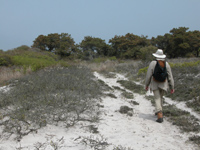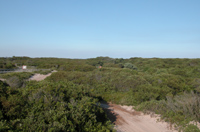 |
 | |
  | |
|
|
|
|
Fire Island National Seashore
Fire Island Wilderness
|
|
|
|
|
| |
 |
 |
| You can hike into the Fire Island Wilderness at any time, but it's best to plan your trip for late fall through early spring, to avoid the ticks and mosquitoes that share this habitat. If you plan to camp, you must obtain a backcountry camping permit (number of people per night are limited) and make special arrangements for overnight parking. |
 |
The Otis Pike Fire Island High Dune Wilderness contains a variety of barrier island ecosystems in a relatively natural condition. It is the only federally designated wilderness area in the State of New York. At 1,363 acres, it is also one of the smallest wilderness areas managed by the National Park Service.
You can enter the Fire Island Wilderness from (which is accessible seasonally by ferry or private boat), Old Inlet (accessible by private boat only), or by the (located adjacent to Smith Point County Park, accessible year round by car or bus). Privately-owned Bellport Beach splits the wilderness into two zones. (See park map.)
Park rangers issue permits for wilderness camping in the Otis Pike Fire Island High Dune Wilderness.
|
 |
| As you hike deeper into the interior of the designated wilderness, you gradually begin to appreciate the sensation of being one with the barrier island. Here, you may truly understand and appreciate the value of wilderness. |
 |
Otis Pike Fire Island High Dune Wilderness is within 60 miles of New York City. This wilderness is so close to millions of urban and suburban populations, yet it provides an opportunity to experience the values of . Surrounded and buffered by high dunes and salt marsh, you can actually feel miles away from civilization.
In the wilderness, you can be free to explore, to discover a natural barrier island ecosystem, to savor the solitude. However, you must respect the natural resources and expect to provide for your own safety. You're likely to encounter , briars, and . From March 15 through Labor Day, are not permitted in the Fire Island Wilderness area or on the beach in front of the wilderness.
|
 |
| As seen from the boardwalk to Watch Hill's life-guarded beach, the Otis Pike Fire Island High Dune Wilderness provides a scenic and serene backdrop for the Watch Hill Campground. |
 |
Be a Good Steward
Everyone has a responsibility to leave the island as they found it. Your efforts to leave it better than you found it—by carrying out more than you carried in—are truly appreciated.
Learn More
The was signed into law on September 3, 1964. Fire Island National Seashore's Otis Pike Fire Island High Dune Wilderness was designated on December 23, 1980 ().
|
 |
| NPS Natural Resource Program Center | |
 |
Visit " Wilderness"
- multimedia education program
|
|  |  |
|
|

Backcountry Permit Desk Hours
Wilderness Visitor Center rangers issue permits for wilderness camping.
more... | | 
Campers take the Ferry to Watch Hill
You may get your wilderness camping permit at the Watch Hill Visitor Center, when staffed.
more... | |
|
|
|
|
|
|
|
 |
|
Did You Know?
Tiny insectivorous plants called sundews (Drosera rotundifolia and D. intermedia) may be found in the low moist swales between dunes in the Fire Island wilderness area. Sundew gets its name from the glistening sticky substance on its leaves that traps ants and other small insects.
more...
|
|
|
|
Last Updated: March 24, 2009 at 15:37 EST |






